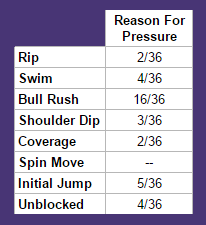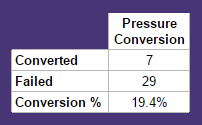
Every year there seem to be a few players that each so-called draftnik in the online scouting community looks back on and wonders how they missed so bad. For me, and I’m sure plenty of others, Danielle Hunter was one of those players from the 2015 draft class.
Hunter was pegged as an uber-athletic pass rusher gifted with ideal size and length for the NFL. The only problem was that he had no clue what to do when actually on the football field. At least we thought. There is no denying that Hunter looked lost at times at LSU, maybe even most of the time. Perhaps we overlooked the fact that when Hunter wanted to be dominant he could be so with the flip of a switch. Many a college defensive lineman seem to have this problem until they reach NFL competition and magically seem to keep the flip switch on permanently.
It seems as though every time there is a player like this in college, they get past their inconsistencies at the next level. Maybe it’s more than a fluke at this point.
In the past few draft classes we have had Timmy Jernigan, Aaron Lynch, Mario Edwards, and Danielle Hunter, among others. Shilique Calhoun is even an example in this year’s class and friend of #PM Hank Jones went in-depth about it for Big Cat Country. There is always inherently more risk with these players than with those that perform consistently in college. When these players flip that metaphorical switch, even if it is only for a few plays each game, it can make a huge difference.
In Minnesota, Hunter has been able to permanently flip the switch. He certainly still does have plays where he looks lost, but any rookie would. The Vikings gameplan on how to sparingly use Hunter has also helped mitigate his inconsistency. The huge mental progression Hunter made during his rookie season and his unique physical talents make his rookie season just the first step in his career. Here is his rookie season through the lens of Pressure Production.

Right off the bat you can see that Hunter played limited snaps his rookie year. He totaled 112 chartable pass rushes in the 8 games charted ( the 8 games in which he played the highest percentage of the team’s snaps), which averages out to 14 per game. Most players end up sitting between 15 and 20 per game. Just on chartable pass rushes that puts him around 3 to 4 snaps behind most of the players I have charted, which probably leaves him around 15 snaps behind overall when counting non-chartable pass rushes and run defense.
What he did with those limited snaps is what made him special as a rookie.
It is to be expected that any rookie, especially one who was viewed as “raw” coming into the league like Hunter, will spend a lot of their snaps not making an impact. Hunter is no exception to that. He certainly had his fair share of disappearing acts but he also had his fair share of game breaking plays.
He spent the large majority of his rushes on the edge against one blocker, which gave him the ability to turn the 32.1% of plays where he won into something more impactful than a pressure.

Hunter won as a pass rusher just as you thought he would when watching him at LSU. Hunter’s biggest redeeming trait is his length and his ability to use it to generate power. That, combined with his ability to generate power from his lower half, makes his bull rush a dangerous threat.
He is a rare rookie that knows both what his biggest strength is and also how to use it to pressure the quarterback. That is an invaluable building block for a young EDGE rusher.
Hunter is also well equipped with counter moves for a young pass rusher, especially one who was billed as raw coming into the league. They aren’t nearly developed enough for him to rely on in a way like Dwight Freeney relies on his spin move, but they are good enough that he can use them occasionally to keep blockers just unsure enough.

What is going to set Hunter apart from many of the other rookie EDGE rushers is his ability to convert pressures into sacks. Not only did Hunter do this incredibly well compared to how rookies usually fare, but he his conversion rate of 19.4% also looks like it will be one of the best period.
Josh Norris made the saying “pressure is production” famous, at least in football circles, but it is now often taken out of context. Pressure is only production if it forces a quarterback to make a mistake or abandon part of the play, which, at least on pressure from the edge, doesn’t happen near as often as it is made out to.
The interior of the line should be where disruption should come from, with EDGE rushers using that disruption to bring a flustered quarterback to the ground. An EDGE rusher who does this as proficiently as Hunter does at such a young age is invaluable to a productive pass rush and a suffocating defense.
Danielle Hunter is just another example of a defensive linemen who was billed as “talented but inconsistent”, for lack of a better term, coming out of college that shelved those concerns and made a big impact in the NFL. He performed at a high level as a rookie, while also providing a cautionary tale of sorts as to why we need to put more weight on flash plays for defensive line prospects.
He is on pace to become a star EDGE rusher in Minnesota.
Anthony Chiado
Latest posts by Anthony Chiado (see all)
- Melvin Ingram: EDGE Rushers Are Good Until They Aren’t - May 4, 2016
- Pittsburgh Steelers 2016 Draft Review: Days 1 and 2 - April 30, 2016
- Aaron Lynch: The master craftsman with only a hammer - April 17, 2016
